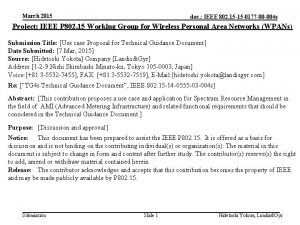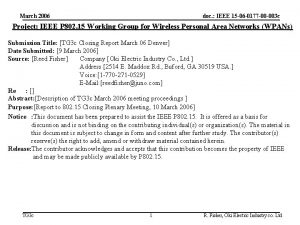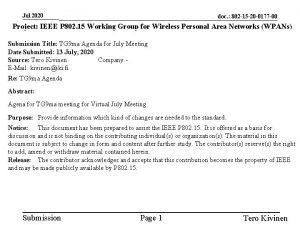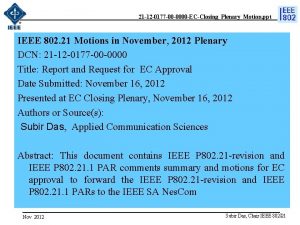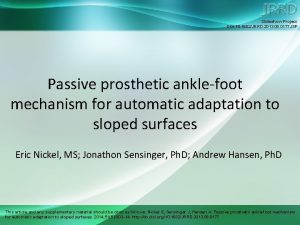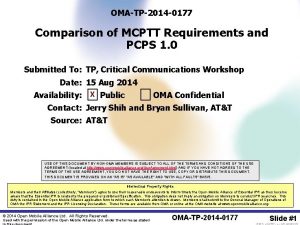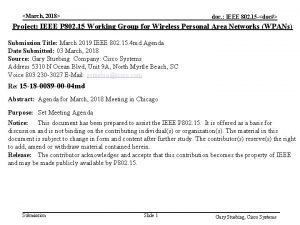March 2017 doc IEEE 802 15 15 0177









- Slides: 9

March 2017 doc. : IEEE 802. 15 -15 -0177 -00 -0000 802. 15 -15 -0248 -00 -007 a Project: IEEE P 802. 15 Working Group for Wireless Personal Area Networks (WPANs) Submission Title: Reply to comments against new PAR/CSD for MG OWC Date Submitted: March 14, 2017 Source: Volker Jungnickel Company: Fraunhofer Heinrich Hertz Institute Address: Einsteinufer 37, 10587 Berlin, Germany Voice: +49 30 31002 768 e-mail: volker. jungnickel@hhi. fraunhofer. de Re: Comments against new PAR/CSD for MG OWC Abstract: This document provides reply to comments against new PAR and CSD for MG OWC Purpose: Response Notice: This document has been prepared to assist the IEEE P 802. 15. It is offered as a basis for discussion and is not binding on the contributing individual(s) or organization(s). The material in this document is subject to change in form and content after further study. The contributor(s) reserve(s) the right to add, amend or withdraw material contained herein. Release: The contributor acknowledges and accepts that this contribution becomes the property of IEEE and may be made publicly available by P 802. 15. Submission Slide 1 Volker Jungnickel, Fraunhofer HHI

March 2017 doc. : IEEE 802. 15 -15 -0177 -00 -0000 802. 15 -15 -0248 -00 -007 a Q&A from Bob Grow on 15. 11 OWC General Q: The project documents do not give any indication why this project should be done in 802. 15. A: Work is already ongoing in 802. 15. Experts are in 802. 15. Work is to be continued in 802. 15. We just restructuring the work already done in 802. 15 to continue more efficiently. Q: It gives no indication of distance the optical communications are to address, no indication of the project having similarities to leverage from other 802. 15 projects. A: Rephrase as : “at distances of 1 -200 m. The standard may leverage previous work in 802. 15. 7 m and introduce MIMO, OFDM, relaying, and mechanisms enabling heterogeneous operation with existing RF wireless data communications standards. ” Submission Slide 2 Volker Jungnickel, Fraunhofer HHI

March 2017 doc. : IEEE 802. 15 -15 -0177 -00 -0000 802. 15 -15 -0248 -00 -007 a Comments from Bob Grow on 15. 11 OWC (2) Q: From the documents, it is impossible to make the determination if the new PAR should be assigned to the 802. 15 WG, another WG, or a new WG. A: see first answer PAR Q: 2. 1 Title: The title could apply to any 802 standard. In the past, people even discussed doing an optical wireless PHY for 802. 3. Though optical is distinctive, there should be more distinctive information in the title, e. g. , something about range of the wireless communication PAN. A: Leave as Multi-Gigabit/s Optical Wireless Communications Nikola: If anything changes include „Specialty“ in the title Submission Slide 3 Volker Jungnickel, Fraunhofer HHI

March 2017 doc. : IEEE 802. 15 -15 -0177 -00 -0000 802. 15 -15 -0248 -00 -007 a Comments from Bob Grow on 15. 11 OWC (3) Q: 5. 1 expected number active on project: The number looks like WG members, not those expected to be active on P 802. 15. 11 draft development and expert review. A: These numbers should be left as they are. They also include people in the background which do not have the opportunity to travel but prepare input documents represented by active WG members. Q: 5. 2 Scope: The range of communication should be specified in the scope. The purpose describes industrial applications as the driving application, yet requirements of automation islands are very different from communication across a factory floor that can be a range in kilometers. A: Rephrase the Scope as “and 10 Gbit/s at typical distances between 1 -200 m. ” The range in kilometers is put in question, several 100 m should be the max. The factory floor will be covered by multiple networked OWC links. Submission Slide 4 Volker Jungnickel, Fraunhofer HHI

March 2017 doc. : IEEE 802. 15 -15 -0177 -00 -0000 802. 15 -15 -0248 -00 -007 a Comments from Bob Grow on 15. 11 OWC (4) Q: 5. 6 Stakeholders: The stakeholders do not appear to align with the purpose statement. Without reach information, are the stakeholders the manufacturers of the manufacturing equipment used to make aircraft and other transportation devices, or is the industry simply the users of the equipment that includes the proposed optical communication capabilities? A: Further clarification of the range has been given that should clarify the stakeholders. Q: 6. 1, b) registration activity: If the standard is expected to specify the use of OUI, CID EUI-48 or EUI-64, it does have registration activity. A: Bob H. will provide an answer. Submission Slide 5 Volker Jungnickel, Fraunhofer HHI

March 2017 doc. : IEEE 802. 15 -15 -0177 -00 -0000 802. 15 -15 -0248 -00 -007 a Comments from Bob Grow on 15. 11 OWC (5) CSD Q: 1. 2. 1, a) Broad Market: 802. 3 has industrial applications and is familiar with shorter range automation islands and longer factory floor requirements, but has no idea what a "personalized manufacturing cell" is other than jargon. A: Rephrase in CSD as “control of mobile robots in a more flexible manufacturing cell or at an assembly line for personalized products where fixed connections will be replaced by wireless in the future, ” Q: Though less important, what relevance the speed of a train has for internal communications is not clear. A: Remove “high-speed” in front of trains Submission Slide 6 Volker Jungnickel, Fraunhofer HHI

March 2017 doc. : IEEE 802. 15 -15 -0177 -00 -0000 802. 15 -15 -0248 -00 -007 a Comments from Bob Grow on 15. 11 OWC (6) Q: 1. 2. 3 Distinct Identity: What is the phrase in transparent media supposed to mean? Wouldn't the non-fiber excluded by 1. 2. 1, b) be transparent? If the requirement is to be only free space, line of sight, then the airplane environment would be very difficult to satisfy without reflective (i. e. , non-transparent) transmission. A: Please replace by “With the exception of 802. 15. 7, this project is distinguishable from all other IEEE 802 standards due to the fact it utilizes optical wireless communications (OWC) instead of RF. ” Submission Slide 7 Volker Jungnickel, Fraunhofer HHI

March 2017 doc. : IEEE 802. 15 -15 -0177 -00 -0000 802. 15 -15 -0248 -00 -007 a Proposed Changes in PAR and CSD Title: Multi-Gigabit/s Optical Wireless Communications Scope: This standard defines a Physical (PHY) and Media Access Control (MAC) layer using light wavelengths from 10, 000 nm to 190 nm for optical wireless communications instead of using RF. The standard is capable of delivering data rates between 1 Mbit/s and 10 Gbit/s at typical distances of 1 -200 m. It is designed for point to point and point to multi point communications in both non-coordinated and coordinated topologies. For coordinated topologies, there may be one or more coordinators with the possibility of a global controller. The standard includes adaptation to varying channel conditions and maintaining connectivity during mobility. The standard adheres to applicable eye safety regulations. The standard may leverage previous work in 802. 15. 7 m and introduce MIMO, OFDM, relaying, and mechanisms enabling heterogeneous operation with existing RF wireless data communications standards. Submission Slide 8 Volker Jungnickel, Fraunhofer HHI

March 2017 doc. : IEEE 802. 15 -15 -0177 -00 -0000 802. 15 -15 -0248 -00 -007 a Proposed Changes in PAR and CSD Need : Given the growing expectation of ubiquitous wireless connectivity in industrial environments, the need for unlicensed, high bandwidth, easy-to-use wireless communications technology, immune to radio frequency (RF) interference and which does not overload existing RF spectrum or necessarily require additional hardware, has never been greater. This standard specifically addresses these needs. In particular, optical wireless based solutions to this problem address a significant opportunity, extending to billions of existing industrial devices, to provide secure, non RF based communications between industrial devices and/or between industrial devices and fixed infrastructure on a one to one, or one to many or many to one basis at acceptable data rates. Potential applications include the control of mobile robots in a more flexible manufacturing cell or at an assembly line for personalized products where fixed connections will be replaced by wireless in the future, automated guided vehicles systems, small cell backhaul, network access in airplanes and trains, security monitoring in petrochemical plants, secure communications in nuclear facilities and hospitals, and many more. There is also a similar emerging need in commercial/business settings, especially in environments requiring high data rates and high levels of security. Stakeholders: Submission Industrial infrastructure and devices manufactures, plant engineering and construction, mobile robot vendors, aircraft and transportation manufactures, medical equipment manufacturers, lighting manufacturers, silicon providers, networking equipment manufacturers, and academic researchers Slide 9 Volker Jungnickel, Fraunhofer HHI










